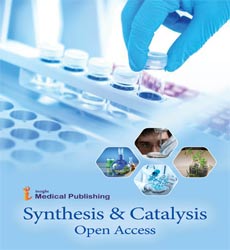ISSN : 2574-0431
Synthesis and Catalysis: Open Access
Enzymes as Versatile and Eco-Friendly Tools for Complex Molecular Construction
Ohtonen Soccio
Department of Materials and Catalytic Science, National University of Singapore (NUS), Singapore
*Corresponding author:
Ohtonen Soccio
Department of Materials and Catalytic Science, National University of Singapore (NUS), Singapore
Email: soccio.htonen@one.sg
Received: February 01, 2025, Manuscript No. ipscoa-25-20550; Editor assigned: February 03, 2025, PreQC No. ipscoa-25-20550; Reviewed: February 15, 2025, QC No. ipscoa-25-20550; Revised: February 20, 2025, QI No. ipscoa-25-20550; Published: February 28, 2025, DOI: 10.21767/2574-0431.2025.11.1.03
Citation: Soccio O (2025) Enzymes as Versatile and Eco-Friendly Tools for Complex Molecular Construction. Synth Catal Vol: 11 No: 1: 03.
Introduction
The drive toward sustainable chemistry and environmentally conscious manufacturing has elevated the importance of biological catalystsâ??enzymesâ??as central tools for modern molecular construction. Enzymes, the highly specialized proteins that orchestrate virtually every biochemical reaction in living organisms, exhibit a unique combination of efficiency, selectivity, and environmental compatibility. Unlike many traditional chemical catalysts that require harsh conditions, generate toxic byproducts, and consume significant amounts of energy, enzymes catalyze reactions under mild temperatures, atmospheric pressures, and aqueous conditions. This makes them inherently aligned with the principles of green chemistry. Moreover, enzymes possess exceptional substrate specificity and stereoselectivity, enabling transformations that would otherwise be difficult, costly, or inefficient with conventional chemical methods [1].
Description
At the core of enzymatic utility lies the molecular mechanism of catalysis. Enzymes accelerate reactions by stabilizing the transition state and lowering the activation energy required for bond-breaking and bond-forming events. They achieve this through highly specific active sites, shaped by amino acid residues and sometimes cofactors, that provide a tailored microenvironment for the substrate. This substrateâ??enzyme interaction, often described by the lock-and-key or induced-fit models, ensures remarkable selectivity. Furthermore, many enzymes exhibit stereoselectivity, producing a single enantiomer or diastereomer in reactions where chemical catalysts would yield racemic mixtures. Such control is invaluable in pharmaceuticals, where the biological activity of drugs is often enantiomer-specific. One of the most impactful contributions of enzymes to green chemistry is their role in stereoselective synthesis [2].
Beyond stereoselectivity, enzymes are indispensable in Câ??C and Câ??X bond formation, central to constructing complex molecular architectures. Aldolases, for example, catalyze stereoselective Câ??C bond formation between aldehydes and ketones, enabling the assembly of carbohydrates and polyketides. Similarly, glycosyltransferases mediate the attachment of sugar moieties to proteins, lipids, and natural products, generating glycosylated molecules with enhanced stability and bioactivity. In synthetic applications, engineered glycosyltransferases have been harnessed for the preparation of therapeutic glycoproteins and novel antibiotics. Halogenases, another class of enzymes, catalyze regioselective halogenation of aromatic compounds under mild conditionsâ??transformations that are notoriously harsh when attempted chemically. These enzymatic Câ??X bond formations provide eco-friendly alternatives for late-stage functionalization of drug molecules, expanding structural diversity without introducing hazardous reagents [3,4].
Another remarkable advantage of enzymes lies in their compatibility with renewable feedstocks and green solvents. Many enzymes function efficiently in water, the greenest solvent available, thereby avoiding the hazards associated with volatile organic solvents. Advances in enzyme engineering have also yielded variants stable in non-aqueous solvents, ionic liquids, and deep eutectic solvents, broadening their applicability in challenging synthetic environments. Furthermore, enzymes can convert biomass-derived substrates into valuable platform chemicals. For instance, cellulases and hemicellulases break down lignocellulosic biomass into fermentable sugars, which are then converted by engineered microbes into biofuels, bioplastics, and commodity chemicals. Lignin-degrading enzymes such as laccases and peroxidases enable the valorization of lignin into aromatic monomers, addressing a long-standing challenge in biomass utilization. These biocatalytic strategies close the loop between renewable resources and sustainable molecular construction. Enzymes have found transformative applications in the pharmaceutical industry, where green synthesis and molecular complexity converge [5].
Conclusion
Enzymes stand at the forefront of sustainable molecular construction, offering a versatile, eco-friendly alternative to conventional synthetic methods. By operating under mild conditions, exhibiting extraordinary selectivity, and enabling unique transformations, they align seamlessly with the principles of green chemistry. Advances in protein engineering, synthetic biology, and computational design continue to expand their catalytic repertoire, allowing chemists to reimagine synthetic strategies that were once considered unattainable. Although challenges remain in stability, scalability, and cost-effectiveness, the trajectory of research and development strongly suggests that enzymes will play an increasingly central role in shaping the future of sustainable chemistry. Ultimately, enzymes embody the fusion of molecular precision and environmental responsibility, offering a pathway to innovation that not only meets industrial needs but also safeguards planetary health. In embracing enzymes as versatile tools for molecular construction, society moves closer to a model of chemical synthesis that harmonizes with nature, ensuring progress without compromise to ecological integrity.
Acknowledgement
None.
Conflict of Interest
None.
References
- Gulati S, Rouilly V, Niu X, Chappell J, Kitney RI, et al. (2009). Opportunities for microfluidic technologies in synthetic biology. JR Soc Interface S493-S506.
Google Scholar Cross Ref Indexed at
- Mohamad NR, Marzuki NHC, Buang NA, Huyop F, Wahab RA (2015). An overview of technologies for immobilization of enzymes and surface analysis techniques for immobilized enzymes. Biotechnol Biotechnol Equ 29: 205-220.
Google Scholar Cross Ref Indexed at
- Velasco-Lozano S, Rocha-Martin J, Santos JCD (2022). Designing carrier-free immobilized enzymes for biocatalysis. Front Media SA 10: 924743.
Google Scholar Cross Ref Indexed at
- Chauhan V, Kaushal D, Dhiman VK, Kanwar SS, Singh D, et al. (2022). An insight in developing carrier-free immobilized enzymes. Front Bioeng Biotechno 10 794411.
Google Scholar Cross Ref Indexed at
- Wang KY, Zhang J, Hsu YC, Lin H, Han Z, et al. (2023). Bioinspired framework catalysts: From enzyme immobilization to biomimetic catalysis. Chem Rev 123: 5347-5420.
Open Access Journals
- Aquaculture & Veterinary Science
- Chemistry & Chemical Sciences
- Clinical Sciences
- Engineering
- General Science
- Genetics & Molecular Biology
- Health Care & Nursing
- Immunology & Microbiology
- Materials Science
- Mathematics & Physics
- Medical Sciences
- Neurology & Psychiatry
- Oncology & Cancer Science
- Pharmaceutical Sciences
